
The word of the future is “access”
An interview with Swiss architect and collector Leopold Weinberg
22/01/2019
The cleverest and most untraditional office table I’ve ever seen is in the Zurich office of Swiss architect Leopold Weinberg. The table top is an authentic map of the London Underground route, which Weinberg rode every morning when he lived in London. “Don’t ask me where I got it,” he laughs. Needless to say, the table where we sit and talk is a conversation piece.
Having previously studied, interned and worked at such prestigious architecture firms as John Pawson, Foster + Partners and Herzog & de Meuron, in 2012 Weinberg and his business partner Adrian Hagenbach founded their own company. Called We Are Content, one of its activities is the creation of new art and cultural content for public spaces.
“Art is a social proposition,” believes Weinberg. He is interested in art as a part of daily life, art as a natural component of life. In this sense, he agrees with critics and theoreticians who maintain that the classic “white cube” takes art out of its context, aestheticising it too much and thus lessening its impact.

Münsterhof restaurant, Zürich © WAC Photo: Christian Grund
Weinberg does exactly the opposite with the projects at We Are Content – his company integrates art into a variety of contexts linked with the rhythms of urban life, provoking new dialogues, interactions, feelings and ideas. One of We Are Content’s projects is Münsterhof, Zurich’s second-oldest permanent restaurant, which was transformed and given new life (both artistic and gastronomic) a few years ago. The Volkshausin Basel and Hotel Helvetia in Zurich are also among the company’s projects. These spaces are all united by the exceptional attention paid to details and their intimately/aesthetically/intellectually inspiring atmospheres. “What we’re doing is we’re bringing different networks together and trying to create a win-win situation. And that has always been with the same goal – to promote art within an everyday life setting,” says Weinberg.
In concentrated form, the reception area at the Hotel Helvetia showcases the essence of We Are Contentprojects. Called a “chamber of secrets”, it is very small yet also embodies an improvised art space with regularly changing displays of artwork curated by the von Bartha gallery. The first thing guests noticed as they crossed its threshold late last year was a neon installation by the Danish artists’ group Superflex. In blue, cursive writing, the words read: “If you don’t like Danmark. Good bye. Fuck off. Go home...” Like most of Superflex’s projects, which tend to involve social sharp-sightedness and a spark of ironic humour, this one, too, has an interesting history.
In 2008, Superflex received an anonymous letter with the above text. The artists deduced that it had been sent in reaction to a series of work they had done in 2002 titled Foreigners please don’t leave us alone with the Danes, which had gained much publicity. Superflex decided to turn this letter into a work of art as well (preserving the original misspelling of Denmark) and thereby make it a part of the group’s own history. The title of the new work is similarly succinct: Letter to Superflex, 14 January 2008.
“Political artwork is maybe not my first choice,” admits Weinberg. “But I like the stories behind some of the works and the way in which they engage with people. Because in the end, if we talk about the business side – be it a hotel, theatre or gastronomy – it is people’s business and we’re selling options, we’re selling experiences. So, our experience is always also linked to art, and art, ultimately, is the luxury of having the time to think about things.”
Weinberg’s private collection of art has also become an integral part of his public projects and, integrated into public spaces, takes on a life independent of its owner. His collection focuses on abstract art, especially art that focuses on geometric forms. From British abstract artist Terry Haggerty to well-known German artist Imi Knoebel and Swiss sculptor Daniel Robert Hunziker. “I’m bringing art into our venues. And actually, I’m extending my home, if you will, through those venues,” Weinberg tells me and adds that in the future we won’t be using the phrase “to own” anymore; instead, we’ll be saying “to have access to”.

The Imaginary Collection: von Bartha X Leopold Weinberg, 2018, Hotel Helvetia, Zürich. Courtesy von Bartha
Tell me about your family background. If I understand correctly, you were born into a family with a long tradition of collecting; it’s kind of in your genes.
Well it’s not a big story there. It’s just that my grandparents had already collected in their own right, and that was passed down to my parents as well. When my mother was a young woman, she used to work for various galleries, also in London. And so, growing up in that environment, and also studying architecture, which I believe is not so far from art...
It’s called the mother of all arts...
Yes (laughs). Maybe the only difference between art and architecture is that architecture by nature has to be functional, whereas art doesn’t have to be. But that’s also the paradox, because by not being it is functional; it has a purpose. So both disciplines are very close, and I have always taken a liking to abstract art, which in turn has a very close relationship to architectural plans. If you draw plans, the relation between the different layers, that certain sense of the three-dimensional versus two-dimensional juxtaposition of elements, that combination or setting...that always interested me, and I find that in art, and I find that in architecture.
So that’s a bit about where I come from. But obviously, I don’t limit myself to that. There has never been a system in my approach to collecting. Maybe ten years from now one might figure out some kind of red line, if one wants to do that; however, I don’t know whether that’s relevant.
I’m not a big believer in this whole hype about art in buildings. For me it’s more like a marketing tool. There are good examples of it, of course, but mostly there are bad examples, I believe. So, we’re not trying to do that. We’re trying to consider art in its own right, in and of itself. We are a counterpart to a museum or a white cube, where everything is toned down and the piece of art is there and you pay for a ticket to go and see it. Our projects are public spaces. Of course, you come to eat in our restaurant or sleep in our hotel. The idea that always interested me was trying to find new ways for how art in an already decorated space – not in a white cube – creates that feeling of home. All of our projects have that feeling of home, and that’s what we’re trying to achieve. Now over the years we’ve established our own way; we have many great collaborations both directly with artists, who have become friends, and with galleries.
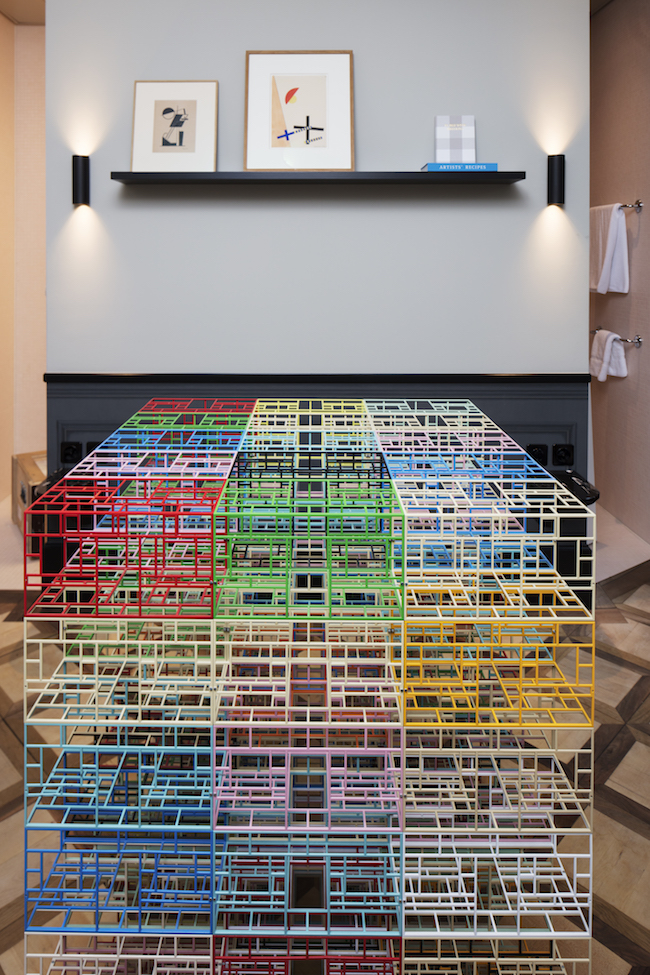
The Imaginary Collection: von Bartha X Leopold Weinberg, 2018, Hotel Helvetia, Zürich. Courtesy von Bartha
One of those examples is our collaboration with Stefan von Bartha and the von Bartha gallery. We’ve done some projects in the past, but the latest was Imaginary Collection, in which I was basically asked to step into the curator’s shoes. I was given access to the von Bartha gallery’s entire collection, and I could make my selection of works and bring them to our hotel for one exhibition. It lasted for just three days, and all of the pieces were for sale. Funnily enough, most people actually felt it was my own collection, which it obviously wasn’t. I actually sold a few pieces, which was also funny in that context. Especially if you think that you’re selling a painting that’s set against colourful wallpaper versus the classic gallery approach.
We call our company We Are Content. So, we produce content for a specific space, not for the public. In the meantime, it is made public, because everyone can go in and everyone is welcome. We’re trying to create dense places with a dense programme. We’re very open, so we have a very mixed crowd, and obviously we attract a lot of artists and creative people, which is nice. Often at our venues you’ll find a t-shirt sitting next to a blazer.
Your personal love is abstract art and art that plays with geometry. Robert Motherwell once said about abstract art: “One of the most striking of abstract art’s appearances is her nakedness, an art stripped bare.”
I find that very well put, because there’s a lot of challenge in reducing something to its essence. There’s a lot of truth in the expression “less is more”.
I used to work for John Pawson in London, who is a bit like the god of minimalism and purism. And there I learnt that it’s not so easy to produce a nice puristic space. Every detail has to be played against the next, and a space should be comfortable with symmetries or with the violation of them. Basically, the relationship between two elements becomes very relevant, and one cannot exist without the other in order to create a formulated tension or make it visually pleasing.
One may argue that minimalism is a reduced form of architecture or art; however, reduction is not easy. Reduction actually needs to come from a very mature hand or brain. At least that’s what I believe.
And that’s the reason why you like it?
Yes, it appeals to me. It is a possible truth and it gives me a lot of pleasure. I think we all know the feeling of when you walk into a space, and some pieces of art just speak to you. And you’re like, wow, this is amazing. At such moments, I have the feeling that I’d love to own it. And that’s the collector in me. But actually, owning is a very interesting topic, especially nowadays.
What is the relevance of ownership today? Can one still afford to own art, because the prices are so absurd? Maybe for very few people on this planet it is affordable, but for the rest it is not. In real estate we know that young people cannot buy anymore; they rent. And over the next five to ten years there will be a lot of changes in accommodating that reality into a business model, somewhere between buying and renting. And also with art.
If you ask Simon de Pury, he will of course, as an auctioneer, say: “How about collectively owning a Picasso?” To be honest, I have big doubts about that, but it is a legitimate question. And with the technology today, that’s certainly another possibility that’s available. I recently had an interesting discussion with a guy who founded a platform, and they collectively bought a work by Picasso. So, I asked him, who owns it now? Who’s the one who decides, for example, whether it goes to the museum or whatever? Is it you? I’m afraid it’s not the 5000 people who bought it collectively, each putting some money towards the purchase. “Yes, it’s me,” he said. “However, the collective can always choose to sell it, and then it will be sold. But the profit will never go back to them; it will be given to a good cause.” And I find that nice in a way.
The question of ownership in art, in real estate, in many other things is probably the most relevant question of our period. Because at the end of the day, I believe it’s not about ownership anymore; the real question is about access. Do you have access to something or not?
Maybe it’s only a question of having access to an experience for a certain amount of time – for an hour, for two hours, for three months. And maybe the future model could be to invest in experiences or in something that curates experiences, and it wouldn’t really matter whether you live in London, Zurich or Dubai or wherever, but you could maybe move around to different flats that are organised by someone, and you’d have an art collection there that you could maybe configure yourself. You’d rent the apartment from the company, and the company would get all the art or collaborate with different galleries, and you’d pay a premium and could say, for instance, I’d like to live with a Picasso for three months and after that maybe with some contemporary art. Insurance-wise it wouldn’t be a problem; you’d just have to make sure that the flat corresponded to certain standards. You could have that or something site-specific. It could be very interesting. To live for three months (or just a week) with a painting that speaks to you and maybe inspires you. Having access to it for a short time. Why not?

The Imaginary Collection: von Bartha X Leopold Weinberg, 2018, Hotel Helvetia, Zürich. Courtesy von Bartha
Doesn’t that go against the essence of collecting, which is nevertheless a very personal process?
Again, it’s a question of whether you can financially afford it or not. Yes, it is personal, but you can also have a temporary personal collection. The only difference, really, is that when your time is up, it’s not there anymore. But when I die, maybe my collection will not be there anymore either. There are just a few people who are powerful enough to have those meaningful collections that everyone talks about. From that perspective, I actually find it an absolutely fair idea. It’s the access you need, not necessarily ownership.
So, I haven’t exactly figured out how to do it, but as you can see, I’ve given it some thought, and it’s something that I’d like to maybe create in the next several years. It’s all about access, and how to facilitate that.
If we’re talking about the future, how do you see the role of the museum in this model?
That’s one of the big topics now. We have public museums and we have private museums. The question is how public museums are funded and how can they survive in the long term, especially if you compare their more bureaucratic structure to the one of a private museum. I believe that museums will remain very important, and I like the idea of having a space where everyone can go to and where something is constantly happening. At the same time, museums can also be a bit not so open, because you have to pay in order to get in.

The Imaginary Collection: von Bartha X Leopold Weinberg, 2018, Hotel Helvetia, Zürich. Courtesy von Bartha
In the meantime, if you go to Tate Modern now, you only have to buy a ticket for the two temporary exhibitions. You can see the rest of the collection for free.
That’s right. It could almost be a Swiss compromise. Obviously the museum needs to generate money, whilst trying to be accessible for everyone. In this sense, there have been conversations going on about how, as a museum, you should deal with the works that you have in your collection. Works that have been bought or donated by your trustees, and then you as a museum, for example, need to build an extension to store and to display it all. So how do you finance that? Can you sell a piece of art? The answer is very difficult, because on the one hand you’ll find enough reasons to justify a sale, but on the other hand it’s an absolute no-go, also because these decisions are related to the person who gave the museum that particular work of art.
What’s happening at the moment is very interesting, because there are a lot of private initiatives, whether it’s the Fondation Louis Vuitton or the museum in Susch that just opened in December. In general, I find it good if people engage with art, if they try to find intellectual stimulation, visual pleasure or even just want to get closer to an artist and his story. And it’s great to live in a society where we have the luxury of affording museums, both private and public. On the other hand, it’s questionable whether it’s intelligent to have so many initiatives next to each other and competing with one another.
Competition is always great, but, for instance, would it not be better if two or three institutions worked together or shared an existing venue and invested money more in that rather than just doing their own ego thing with their legacy? Because together you could then maybe do something really amazing. Would we lose variety? Maybe. Maybe not. You know, at some point it also obviously has a lot to do with ego.
I suppose that at its core, collecting has very much to do with ego.
Well, it’s questionable whether, at the end of the day, it’s the best solution for the user to have all of those different initiatives, whereas maybe some could be combined and made into the ultimate experience.
For example, there are, I think, around 270 art fairs all over the world now. And it’s also very evident why there are so many. The states back them as well, in an effort to bring tourism in and improve the economy. It’s city marketing, and it’s quite an interesting thing. I mean, you have cities competing over tourists, over people. And art is a very welcoming, easy way of saying “Oh, we are cultural, we are interesting, and that’s exactly the crowd we want.” It’s maybe not that straightforward, but that’s what’s happening.
Even if we look at what’s happening now in Susch, a very remote place in the Swiss mountains. A collector and entrepreneur is building a museum there, and thereby is investing money in the local economy. This is fantastic and certainly a welcome impulse in the context of all the efforts that have already been made within the art world in the Engadin Valley. But is it sustainable? Is it the right thing for a remote place to do that or not? I don’t know. I love it, and the courageous and entrepreneurial spirit is to be admired. It will be interesting to observe how it will integrate over time within the local structure, on a daily basis, and how it will manage to keep attracting people from abroad with an appealing and fastidious programme.
It means that, in some way, you could completely change a place, build infrastructure with art. On the other hand, is it sustainable?
And that is, in a way, also scary. The question is what happens the other 340 days of the year, when it’s not high season, and over the next five years. Let’s move away from art. The Olympics are a very good example. They put all that money into the games, they build the venues, and then they’re used only for a short time, and after that so often become ruins. The venues are not used anymore; they become a ghost city. In London, at least, this problem was a concern. I was working for an architecture company in London at the time, and our office was also involved in the Olympics; we built one of the big blocks of flats for the athletes. It was called Athletes’ Village. The units were very small, and then after the Olympics you just had to tear down one wall combining two small units and you had a normal-sized flat that could be used as a regular apartment. So those things were cleverly done, however, there are also a lot of ruins out there. When someone is in charge of any project of such magnitude, I think one has to seriously consider what one is doing and what impact it has.
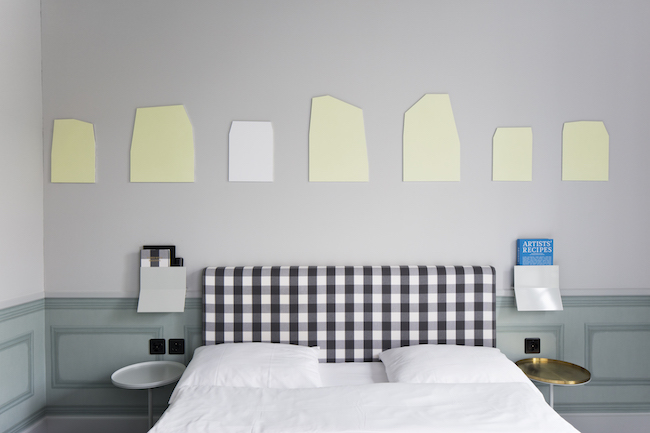
The Imaginary Collection: von Bartha X Leopold Weinberg, 2018, Hotel Helvetia, Zürich. Courtesy von Bartha
Regarding museum buildings, only some of them are true homes for art. Finding balance between the architect’s ego and the museum’s essence and main mission is not always easy.
For me, Louisiana is an amazing example. It’s not super pretentious, it’s very low-key, and there’s this beautiful interaction between inside and outside.
Architecture can be a very powerful tool, as we know from the Second World War. Hitler knew that quite well, looking at Speer’s compositions and monumental work. Also historically, churches had this element of intimidation in the sense of overwhelming spatial power. Tate, for example, and in contrast to Louisiana, has a kind of church-like feeling when you enter the space and you feel so small. This spatial decision obviously has an impact on the visitor and, much more interestingly, gives the pieces that are shown arguably more gravitas. It’s very interesting what architectural space or design details can achieve in regard to feelings.
If I understand correctly, for you, art is more of an intellectual challenge than aesthetic pleasure.
Again, I like the duality. You know, if a little child sees a piece of art and has no idea about it, it still can speak to him. So that’s right. And little by little this small child becomes a big child and may develop an interest beyond the aesthetic one. It’s a bit like love at first sight. At first an aesthetic attraction. Eventually this love may grow into something more complex, more meaningful, by adding the intellectual dimension. So, if that child grows up and eventually understands the theory behind the piece of art, it will unlock even more doors.
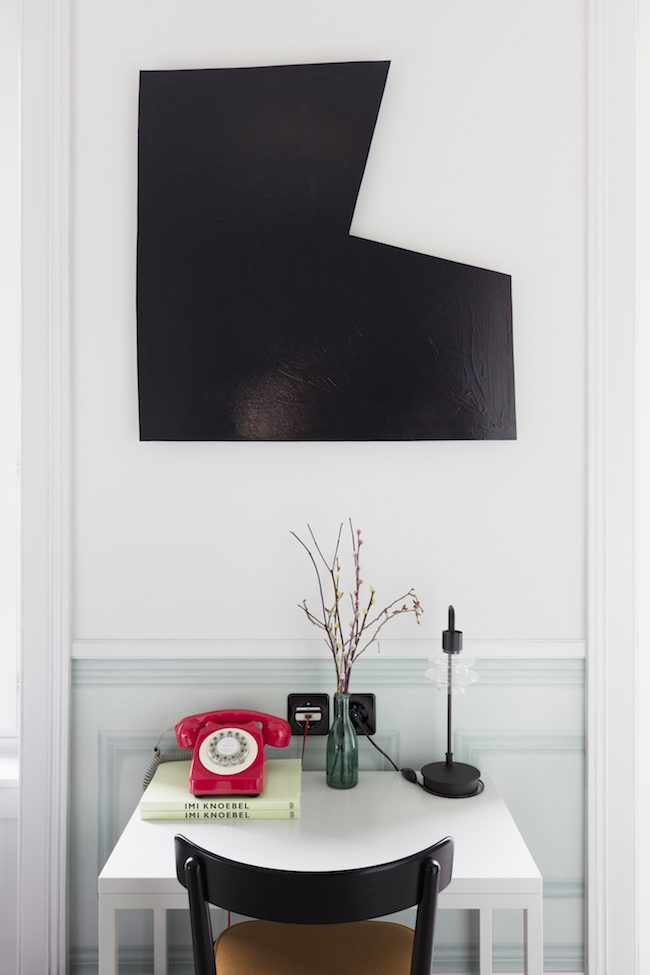
The Imaginary Collection: von Bartha X Leopold Weinberg, 2018, Hotel Helvetia, Zürich. Courtesy von Bartha
But is it important for you to know the story behind the artwork?
Yes and no. I always like to have more information and to understand. But I also think that a piece of art can just stand on its own without all of that information. Again, like in architecture. If you go to any architect who does his or her job well, there will be a lot of theory behind their designs, a lot of reasons. Everything basically has to have a “raison d’être”. But at the end of the day, it’s a building that either stands apart, and you either like it, or you don’t.
To understand the logic is important, but one can also over-theoretise things. Yes, it interests me, but I also like the naive approach when you either like something or not. I’ll never buy something just because people tell me I have to have it. If I do not like it aesthetically, I would never go for it. Many people – so it seems – who have enough money to afford established artists, buy the same thing. Their collections almost become exchangeable. Like, one buys a Warhol, and then everyone is buying a Warhol. How boring! It’s much more interesting – and also challenging – to stand for something that speaks to you, interests you and makes sense to you personally.
When you add a new piece to your collection, do you feel a need to have it around you?
I’m an art addict. I don’t need to have a wall to fill in order to buy art. I don’t have so many walls, so I have to change things around. What I’m trying to do is to keep it dynamic. Everyone has their time, and also every work of art has its time at its own point.
The nice thing about it is that I’m mixing the art into our business. My business partner and I are bringing art into our venues. And by doing so, I’m extending my home, if you will, through those venues. Very often I’m there almost daily, but sometimes I’m gone for two, three months, and then I go in and I have that sensation again of “Wow, that’s nice.”
Otherwise you should keep it all in storage.
I dislike the storage factor. Look, for many people, art has become a way to invest money, to make money or sometimes unwillingly also to lose money. There – in the absence of emotions – storage seems valid. However, I’m very confident sitting in front of you and telling you that I don’t do it for speculation. I do not want the work of art to disappear in a box; I’d rather live with it and enjoy it. Of course, I don’t mind when the price goes up. But then again, I’ve never sold anything. I never buy something just because I think it’ll be worth so much more in the future. It has to speak to me, it has to be right for the project. I often buy a piece with no clear idea in my mind of where I’m going to put it. But it will happen, it will eventually find its perfect spot.
Funnily enough, only in regard to access through ownership does storage become an issue. Maybe this is the right time to break that down and come up with different access models through which storage becomes obsolete.
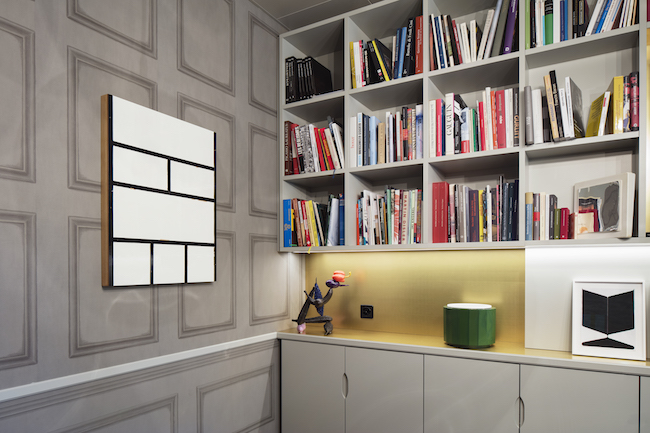
The Imaginary Collection: von Bartha X Leopold Weinberg, 2018, Hotel Helvetia, Zürich. Courtesy von Bartha
Even though you’ve never sold a work of art from your collection, you nevertheless admit that it’s nice to see the prices of works go up. How emotionally important for you is this conditional acknowledgement of the art market?
It gives you some level of thrill. Confidence, maybe. The idea of theoretically having made money with a right decision is stimulating. And we also enter into the same conversation we had before about museums, whether it’s legitimate to sell a piece of art or not. We can also speak about a collection in this respect. Let’s pretend you bought something, and it’s now worth ten times more than what you paid for it. And if you sell this one work, you could afford to buy ten new paintings. So why not? There are some people who say that, as a real collector, you can never sell something. I’ve never done it, and I also understand why people say that. In the meantime, you can always have certain strategies when buying. For example, you can have a policy of always buying two pieces by the same artist, which leaves you the freedom to at some point decide to keep one and sell the other in order to buy more.
In our case, we grow organically, and there’s a certain amount of money I’m happy to spend on art every year given the right opportunity. Non-buying strategies are also welcome, such as various collaborations. For instance the “imaginary collection” we did with von Bartha, in which we had the possibility of showcasing amazing pieces of art over a longer period of time at our hotel. By now, we are in a position that allows us to do collaborations with relevant partners. We worked hard for that and developed a certain credibility in our art-related undertakings. Doing initiatives like that, being connected with more people, equals more access. So I would say that ownership is one thing; another thing is networks and collaborations with other institutions and galleries, which create a win-win situation.
You collect work by living artists. Why is it so important for you to collect from your own era? Is a collection a sign of its time?
Yes, living artists interest me more, because I like the engagement. It’s like when you have an author of a book who is dead – yes, you can read the book, maybe you have an opinion about what he or she meant by it when the book was written. But if you have a living artist, you can ask the person. I’m very much in the here and now. Actually, my collection will maybe leave a trace of the artists I knew or got to know and where I lived or moved or what networks I joined. Will these things be relevant or not? It doesn’t really matter. I don’t have any primary intention of my collection being relevant. That’s not my ambition. My ambition is to enjoy art during my lifetime.
What comes after me...obviously, I wish my kids only the best and for them to be happy and maybe to continue the collection. So that’s for sure. But I’m quite a realist, because they might turn out to have completely different taste. And I would not cry for one second if one day they decided to sell everything. Whether they’ll make any money from it is a completely different question, but then with that they could do their own thing. That would absolutely be fine with me.
Art has served a purpose for me in the sense that I’m enjoying it so much and I’ve met so many interesting people through it. It helps my design work and my projects, which have become more alive. It creates content as well. And it’s not just content, but it’s important content. It’s a cultural proposition, cultural fuel. What more you could ask of it?
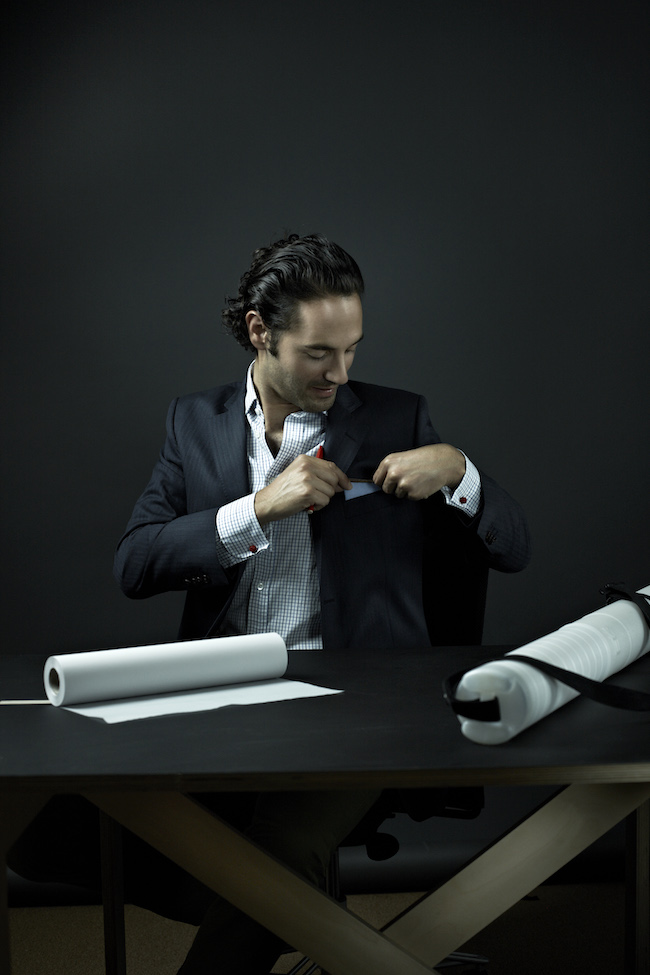
Leopold Weinberg